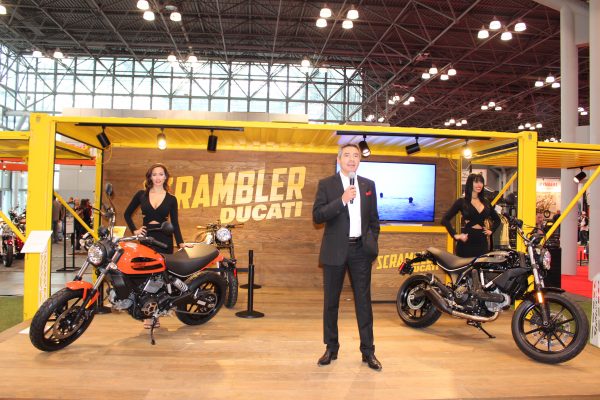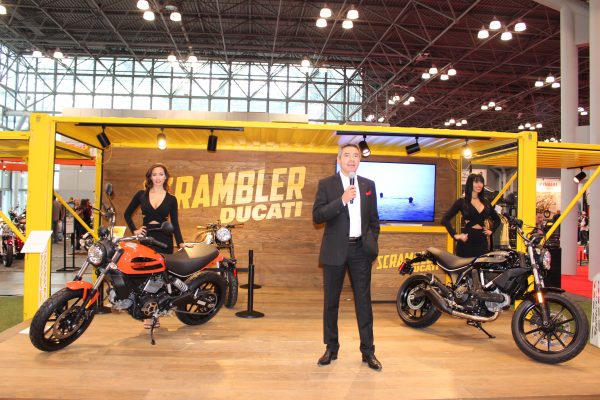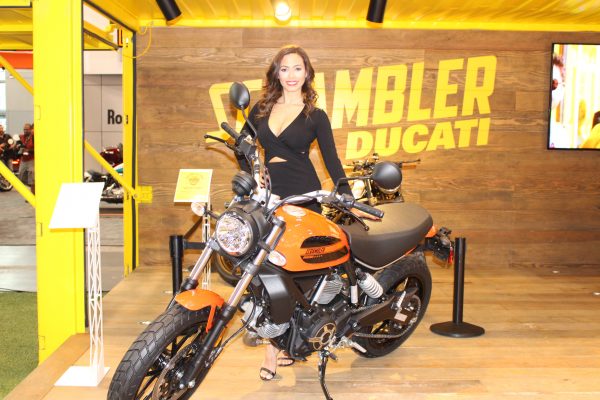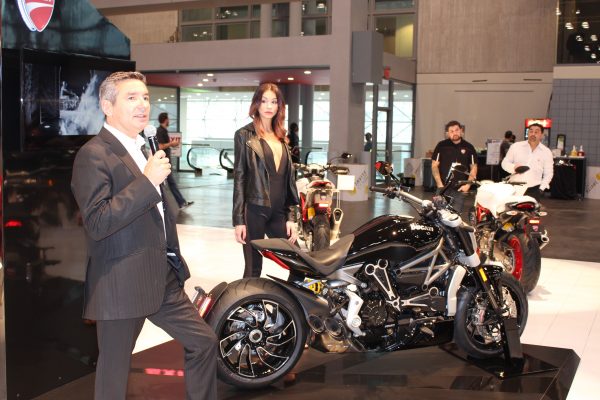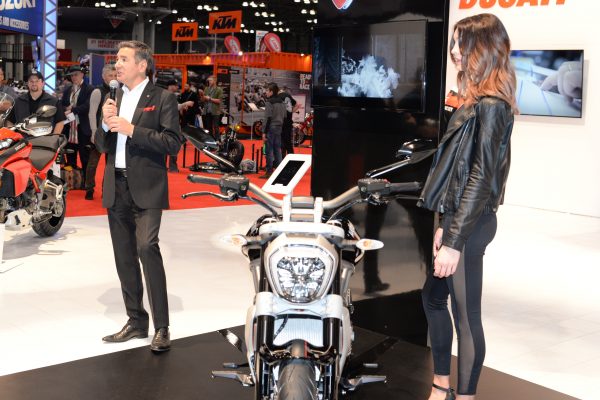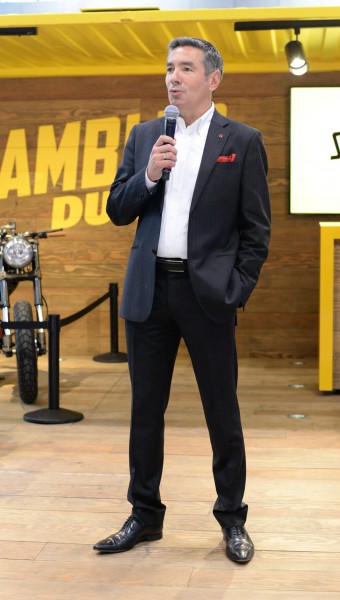NEW YORK – The outgoing CEO of Ducati North America, Dominique Cheraki, attended the Progressive International Motorcycle  Show over the weekend and touted the company’s new 2016 models to the press. On Jan. 1, he will become Ducati Network Devlopment Director at headquarters in Italy, with Jason Chinnock becoming CEO of Ducati North America.
Show over the weekend and touted the company’s new 2016 models to the press. On Jan. 1, he will become Ducati Network Devlopment Director at headquarters in Italy, with Jason Chinnock becoming CEO of Ducati North America.
After showing off the new XDiavel cruiser and the smaller Scrambler Sixty2, the French-born Cheraki talked witth RIDE-CT & RIDE-NewEngland about the state of the motorcycle industry, the potential impact of the scandal involving parent company Volkswagen’s problem with diesel emissions on Ducati, and the new models.
Ducati’s Scrambler line, which was launched a year ago, has caused a scrambler frenzy with even BMW deciding to come out with a scrambler model. Ducati has downsized the Scrambler for 2016 with the Scrambler Sixty2. It has a 399cc engine versus the 803cc engine in existing Scrambler models. But with an MSRP of $7,995, it will sell for only $1,000 less than the existing Scrambler Icon.
The interview with Cheraki began by talking about the Scrambler. A video version appears at the bottom:
BW: Scrambler came out last year as its own brand with several models. Did you ever expect it to be as successful as it was?
DC: Yes, somewhere, yes. Maybe not in the quantity, but, yes, we had a lot of good sign(s), lot of positive response to the marketing activities, so it was very visible. But then the final numbers for the first year is, yes, maybe a surprise somewhere, a very good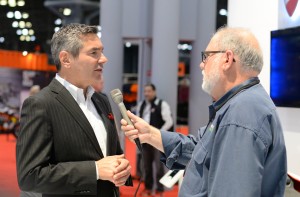 surprise, everywhere in the world, not only here in the U.S. or in North America, everywhere in the world.
surprise, everywhere in the world, not only here in the U.S. or in North America, everywhere in the world.
BW: I used to cover television back in the day and there used to be a saying that imitation was the sincerest form of television. Is that true in motorcycles now; imitation is the sincerest form of motorcycling with other companies now saying, ‘Hey, Ducati had a hit. I have to have a scrambler now?”
DC: I don’t know. Everybody is going to make his own mind on the way to do the right thing and to build the right bikes. At least we have a lot of legitimacy with this motorcycle. The bike was launched in the U.S. 1962; coming back with a bike which is a reinterpretation. You remember last year what we said when we launched the Scrambler was we build the Scrambler as if we never stopped the production. If we had the Scrambler in the model line for the past 30 years, it would probably be the Scrambler that we have today.
The fact that it’s opening new world, new option for this industry, it’s good because the first idea is also to make the motorcycle accessible for a young generation and for people that are interested by in motorcycle(s) but are not interested by the performance, the power, the speed, and everything.
BW: Looking at all the brands here and all the models, do you think there’s ever been a time when there’s been this variety of motorcycles?
DC: No, and I’m very happy that it is like that… The choice is important. Everybody has his own interpretation of what should be motorcycling and what is fun, and you find the fun in different models. The answer is really we have never had so many models everywhere in this industry and it’s very good.
BW: What do you say to critics who may say, yeah, you’ve come out with a smaller Scrambler, it’s a great looking bike, but it’s not priced low enough below the existing Scrambler. Is that a concern of yours?
DC: No, it’s not a concern because we knew that we could not produce the 400 with a price which is… If you look at the engine, you’ll see that it’s an 800 which is (a) 400. There is nothing really different from the original (Scrambler) Icon, so we knew we could not be competitive. And that’s not the idea. The idea is that pricing them is that they are an option in the market. If you really want to buy a non-expensive motorcycle, it’s not Ducati. It’s not what we are able to do. We have a small production. We are producing 50,000, a little bit more now, 50,000 bikes per year. So the idea was what we want is to give an alternative, to inspire and give an option.
BW: As far as the XDiavel, I rode the original when it came out. Had a great time with it. At that time it was described 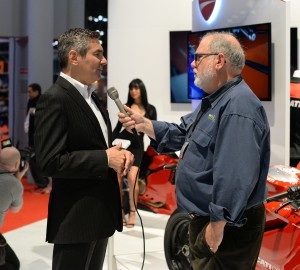 kind of broadly as a power cruiser even though it didn’t have feet forward foot pegs. This is the next step for Diavel. What is your hope that it will tap. Who do you hope that it will bring in that didn’t go for the original?
kind of broadly as a power cruiser even though it didn’t have feet forward foot pegs. This is the next step for Diavel. What is your hope that it will tap. Who do you hope that it will bring in that didn’t go for the original?
The first one was a slight and step-by-step introduction in this market. It’s a completely different market. It’s a huge market here in the U.S. With the Diavel, we were very surprised at the launch of the bike that it was elected as the best cruiser of the market. Was it really a cruiser was a point of conversation. If you remember, we even made an advertising campaign saying, “I’m not a cruiser.”
Now with the XDiavel we wanted to really go one step further and make a reintroduction in this market. We are going to tap probably people that are very interested by all the (elements) of the cruising market. You want the feet forward riding position. It’s a very cool and comfortable riding position, but, in the meantime, someone who is going to be very interested by the sophistication, by the electronics we have on the motorcycle, by somewhere the type of performance. The bike has been equipped by the belt transmission, which is also another first for Ducati. We did everything in order to combine both worlds. That is the reason why we call it the XDiavel, which is really the intersection in-between the Ducati world and the cruising world.
BW: One last question, I saw you on Bloomberg the other night. The first clip they played with the CEO of Volkswagen saying, “We are not going to sell Ducati.” Everyone knows about Volkwagen’s problems with the diesel emissions and that whole horror story as it were. You may be a small cog in the whole world of Volkswagen, but the fact you have so many bikes that are just starting to come out now, does that put you in a better position given what Volkswagen is up against? Or are you such a small cog that you don’t have to worry about them saying, “Well, we need to cut their R&D, we need to rein them in a little bit”? Are you in a good place now given Volkswagen’s problems?
DC: We have a very good R&D plan for the future. We will bring in the next five years many new products, and the investment that have been in the past five years and will come for the next five years will be very visible with all the models that we will introduce, so we have no concern about our ability to bring a lot of new models in the future.
Photos by Bob Rosen and Bud Wilkinson
 Ride CT & Ride New England Serving New England, NYC and The Hudson Valley!
Ride CT & Ride New England Serving New England, NYC and The Hudson Valley!

